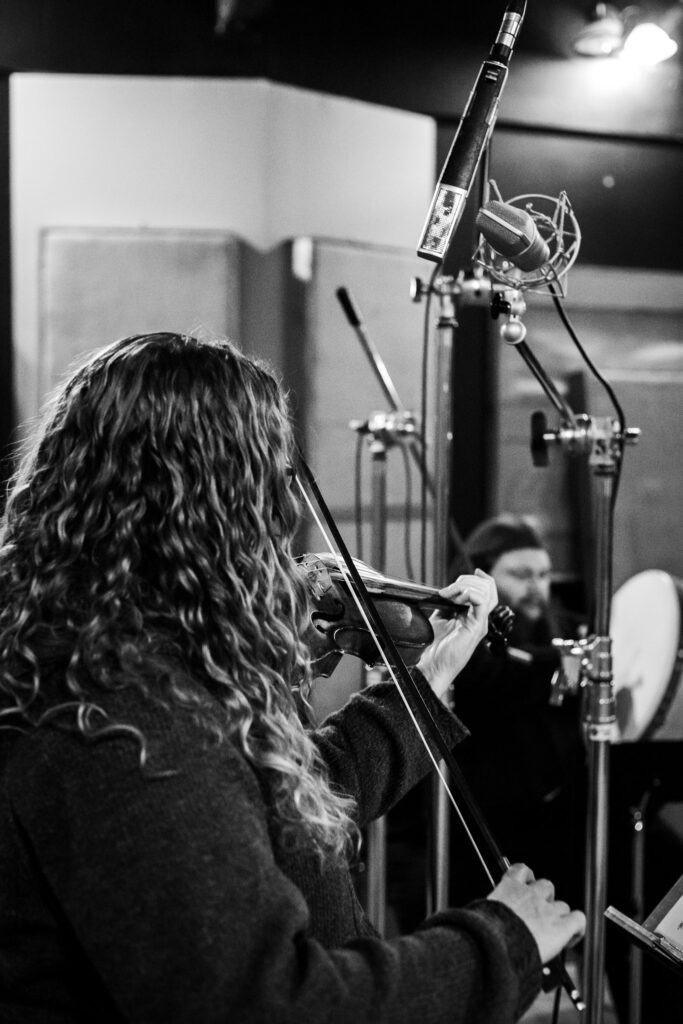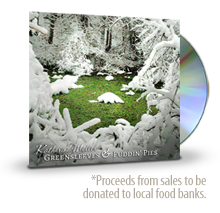3 Ways to Record an Album
January 27th, 2023 by Katherine Moller

I am going back to the studio this coming weekend to record my final fiddle tracks for my next album, so I thought I might share with you how this whole process works.
There are a couple of different ways to record. Here are three ways I have recorded my albums in the past:
Live off the Floor
For my last album, “Tea & Tunes”, we recorded what is called “live off the floor”. What that means is that Kim, Tom Richards and I all went to the studio together, sat in the same room, and played for the recording just like we would in a show. They had microphones set up to capture the sound from each of our instruments, but because we were all in the same room playing at the same time, the microphones would pick up the sounds of other instruments as well.
This way of recording gives you a really natural sound, and is a lot of fun because you get the energy from the other players, but also has the disadvantage that if you mess up, but everyone else plays their part perfectly, you’re going to have to decide whether you keep it, or everyone has to record again!
Together but in Separate booths
For many of my other albums (like “Bright-Eyed & Bushy-Haired” and “By Request”), Skip Holmes (guitar, mandolin, banjo) and I would go to the studio together. We would be in separate rooms, but able to see each other through a window. We would play together to record, so you still have some of that live feel, but if one of you messes up, and the other had their best take, you can simply re-record the one instrument. This means that you get the best performance from each person. Usually, we would then do over-dubs where I might add another violin part, or he might put some banjo or mandolin into a tune. You are recording another part over the original parts that you have already recorded.
Listening to Scratch Tracks
Now for “Storm Queen” and this current album, I am recording in a different way. I went to the studio with an arranger and the producer. The three of us picked out the tracks (I already had a short list) and worked on arrangements. I then recorded what we call scratch tracks. These are recordings of my fiddle that will never be heard by the public.
In November Karl Gans (drums), Jason Flores (bass), and Skip all came to the studio with me and recorded their parts to my scratch tracks. They recorded much the way that Skip and I usually record together. Now I will be going back in to record my final good tracks which are the ones that you will be hearing. In this case, by me going down alone first (with the arranger and producer), we were able to work out a lot of details without having to use everyone’s time. Again, we will get everyone’s best performance.
In the case of Kevin Fox, who is playing cello on a track, he didn’t even leave home. He lives in Ontario, so we e-mailed him the track he is going to play on. He is recording in his own studio and then will e-mail the track back to us.
Which way is best?
They all have their advantages! With “live off the floor”, you get the closest thing you can to a show, but each person’s individual performance may not be the best. Skip and I usually go kind of in between with recording live together, but being isolated in separate booths. Recording this album with scratch tracks lets you be fancier with the arrangements, but a lot of people are recording by themselves listening to a pre-recorded rough draft.
I can’t wait to be able to share the final product with you! I am excited about how everything is coming together!
Comments are closed.


